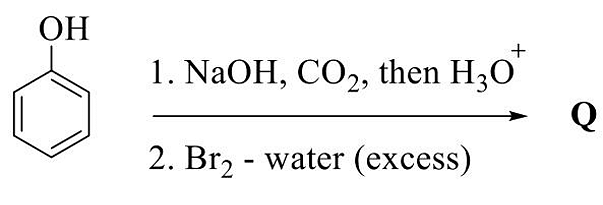Which one or more of the following statements is/are correct regarding the electromotive force generated by the electron transfer chain?
Show Hint
- ( It is used for the synthesis of ATP. )
- ( It is not used for active transport processes. )
- ( It includes a pH gradient component. )
- ( It does not include an electrical potential gradient component. )
The Correct Option is A
Solution and Explanation
Analysis of Each Statement: (A) It is used for the synthesis of ATP: This is correct. The electromotive force generated by the electron transfer chain is indeed used to drive the synthesis of ATP through chemiosmosis in the mitochondria.
(B) It is not used for active transport processes: This statement is incorrect. The proton gradient created by the electron transfer chain, part of the electromotive force, is used for various active transport processes across the mitochondrial membrane.
(C) It includes a pH gradient component: This is correct. The creation of a proton gradient, which involves a difference in pH across the mitochondrial membrane, is a critical component of the electromotive force used in ATP synthesis.
(D) It does not include an electrical potential gradient component: This statement is incorrect. The proton gradient results in both a pH gradient and an electrical potential gradient across the mitochondrial membrane. Conclusion:
Thus, the correct statements that accurately describe the electromotive force in the electron transfer chain are (A) and (C). This force is central to the mitochondrial process of energy conversion from nutrients to ATP, coupling electron transfer with proton translocation and ATP synthesis.
Top Questions on Mass spectrometry
- The major product in the given reaction sequence is Q. The mass spectrum of Q shows
([M] = molecular ion peak)
- GATE CY - 2024
- Inorganic Chemistry
- Mass spectrometry
- Which among the following characteristics of Laser light specifies the precise movement of all individual light waves together through time and space?
- AP PGECET - 2024
- Instrumentation Engineering
- Mass spectrometry
- Recombination of electron-hole produces ____ in LEDs.
- AP PGECET - 2024
- Instrumentation Engineering
- Mass spectrometry
- Magnetic sector analyzer is a part of
- AP PGECET - 2024
- Instrumentation Engineering
- Mass spectrometry
- Which ionization technique in mass spectrometry is most suitable for large biomolecules like proteins:
- GPAT - 2024
- Pharmaceutical Analysis
- Mass spectrometry
Questions Asked in GATE XL exam
An electricity utility company charges ₹7 per kWh. If a 40-watt desk light is left on for 10 hours each night for 180 days, what would be the cost of energy consumption? If the desk light is on for 2 more hours each night for the 180 days, what would be the percentage-increase in the cost of energy consumption?
The \( F_{121} \) value of a known microorganism with \( Z \) value of \( 11^\circ C \) is 2.4 min for 99.9999% inactivation. For a 12D inactivation of the said microorganism at \( 143^\circ C \), the \( F \) value (in min) is .......... (rounded off to 3 decimal places)
- GATE XL - 2025
- Food Technology
- Consider a five-digit number PQRST that has distinct digits P, Q, R, S, and T, and satisfies the following conditions:
1. \( P<Q \)
2. \( S>P>T \)
3. \( R<T \)
If integers 1 through 5 are used to construct such a number, the value of P is:- GATE ST - 2025
- GATE CS - 2025
- GATE MN - 2025
- GATE XE - 2025
- GATE XL - 2025
- mathematical reasoning
Three villages P, Q, and R are located in such a way that the distance PQ = 13 km, QR = 14 km, and RP = 15 km, as shown in the figure. A straight road joins Q and R. It is proposed to connect P to this road QR by constructing another road. What is the minimum possible length (in km) of this connecting road?
Note: The figure shown is representative.
- A business person buys potatoes of two different varieties P and Q, mixes them in a certain ratio and sells them at ₹192 per kg.
The cost of the variety P is ₹800 for 5 kg.
The cost of the variety Q is ₹800 for 4 kg.
If the person gets 8% profit, what is the P : Q ratio (by weight)?